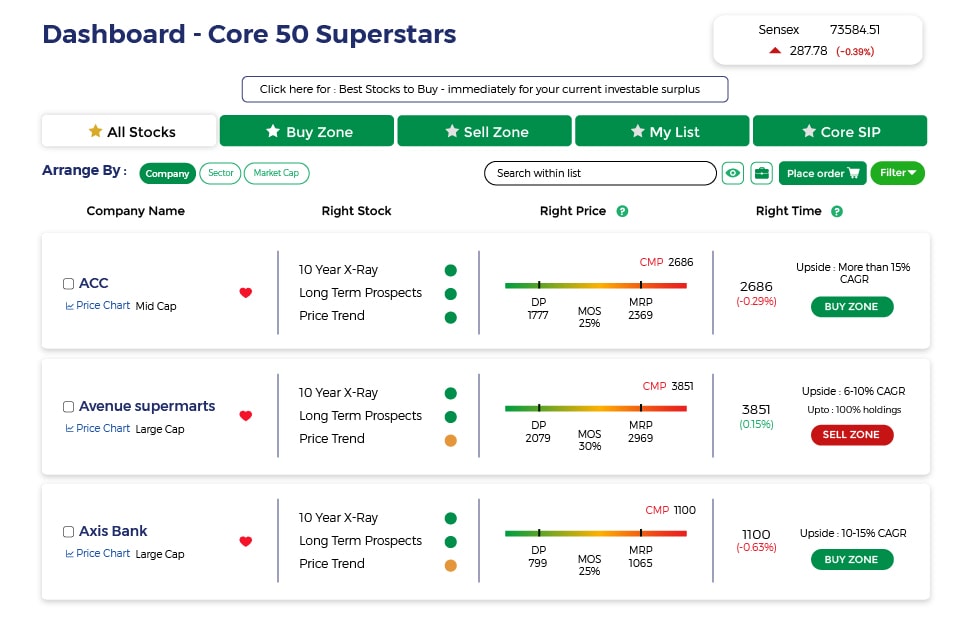We all suffer from Buyer’s Remorse ...
After you buy, if the prices go down, you wish you had waited; and if the prices go up, you wish you had bought more. The same thing happens when you sell a stock. Your ability to handle this remorse makes you a better investor. But one forgets that one is always wiser in hindsight, after the event. So, how do you buy and sell in a way that you don’t suffer or at least minimise remorse, and at the same time improve our risk-adjusted returns?
Successful investing is all about building and managing a portfolio, not picking stocks, and maximising returns on every stock. This enables you to allocate a substantial portion of your savings to equity and manage your emotions better, as the market goes through its up-and-down cycles. As mentioned, in ‘How to build a portfolio?’ you need to have a maximum allocation to every stock that you buy. At MoneyWorks4me this ranges from 3% to 7%. Now, the question that needs answering is, 'How do you go about buying this?' Do you buy 100% of the required allocation, say 7%, in one go at one price? No, this has many downsides in terms of returns performance, but more importantly, in generating remorse, which can be counterproductive. It’s better to buy and sell in instalments or tranches.
Why is 'Buying in Tranches' a better process?
When buying anything, we get anchored to a price. In the absence of any solid method to choose an anchor, we go for 52-week high and low, a certain PE or P/BV, or a friend's/analyst's tip or target price, etc. At Moneyworks4me we recommend using the stock’s MRP-Fair Price as an anchor. We then buy at a discount from the MRP based on the Margin of Safety, MOS, and sell when a Premium above the MRP is available. However, none of this is cast in stone nor can be estimated with a very high degree of accuracy. However, they serve as a very good guidepost when taking decisions. Also, there are no guarantees about when the market will offer the stock at the exact MOS, if at all. So, as a process, we buy in tranches. Simply put, if the price of a stock falls and you execute all the buying tranches/instalments, your average buy price will be close to the intended buy price.
How does 'Buying in Tranches' work?
Suppose you intend to buy 300 nos. of a stock at Rs. 100. You now plan your purchase in three equal instalments at Rs. 107, 100 and 93. Your average buy price would still be Rs. 100. However, stocks and markets don’t behave in a predictable manner, and you need to check how the method works under different scenarios.
- The market price reaches the first tranche price, i.e. 107 and then rises again. Here you would be happy to have bought some shares, even if the price was higher than your intended price. This tends to happen with very good company stocks, which tend to fall below only marginally below its Fair Price, if at all
- If the price falls below 107, you don’t get disappointed by the fact that you have lost some money on the first 100 shares, but wait for it to reach 100 and buy the next tranche. Now, your average buy price is 103. The stock can then move either up or down. If it moves up, your paper loss reduces or is eliminated, making you happy, and if it continues above 103.5, you start seeing paper profits.
- If the price falls below 100, you go through the same emotions as above all the way to 93 when you buy the last instalment.
Now, between the stock prices of 93-107 you have used the market and stock volatility to buy rather than get demotivated or paralysed by it. Now, if the stock is at 93, you have made a paper loss of 7% on it. But how much is it at your portfolio level? If the max allocation was 7%, it would be less than 0.5% of your portfolio. You will unlikely to lose sleep over this one stock.
The process of buying in tranches preconditions the mind to accept stock price volatility and reduces remorse. Of course, the process works best when you have a reasonable correct Fair Price and a good estimate of the MOS.
When selling, 'Sell in tranches'
Similarly, when selling, we recommend selling in tranches, usually two, based on the premium over the stock’s MRP. The premium depends on the quality of the stock’s performance in the past, and our expectation of its future performance. If the current price seems to have factored in the future growth beyond a reasonable level, we expect the market to eventually revert to its Fair Price in the long term, and hence, the chances of a price correction increase substantially. We prefer to be fearful when the market is greedy, and recommend selling partly or fully depending on the Premium the current prices seem to offer. We would prefer to reinvest this in other opportunities which offer better risk-adjusted returns.
When we do this, the remorse of selling too early is prevented first by the premium and next by the tranche.
Also Read: ‘How do you build a stocks portfolio that helps you meet your financial goals?’
Already have an account? Log in
Want complete access
to this story?
Register Now For Free!
Also get more expert insights, QVPT ratings of 3500+ stocks, Stocks
Screener and much more on Registering.








 Download APP
Download APP























Comment Your Thoughts: